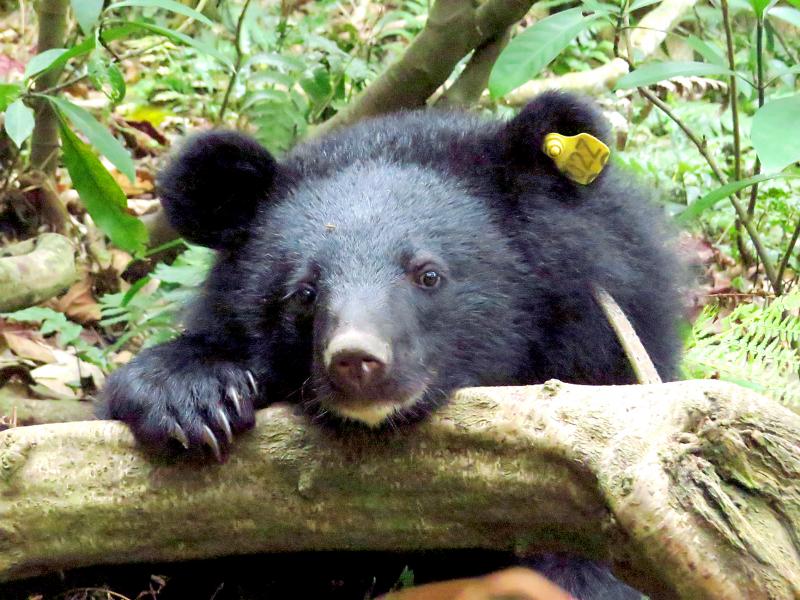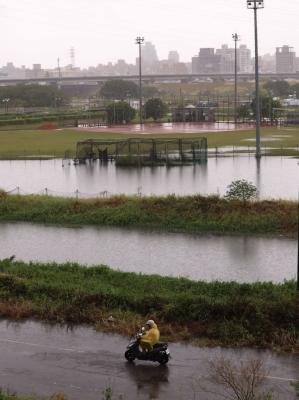The long-term movements of a Formosan black bear were revealed for the first time on Monday, marking what officials said was an “important milestone” in the conservation of the threatened species.
The results of the rehabilitation and tracking effort were detailed at a Forestry Bureau event in Taitung County, which also premiered a short film, titled Mulas, Kulumaha (返抵山林), to document the story.
In July 2019, a Formosan black bear cub was discovered by residents of Taitung County’s Guangyuan Village (廣原).

Photo courtesy of the Forestry Bureau
In honor of the village leader’s name and the cub’s perseverance, the locals named the cub “Mulas” after the Bunun word for “wild strawberry.”
Only a few months old when found, Mulas was given to the Taitung Forest District Office, which raised the cub for 10 months.
Before releasing her back into the wild in May last year, Mulas was fitted with a GPS tracking collar capable of remote release.
The 405 days of data collected before the collar was removed in June are the first time a Formosan black bear’s activity in the wild has been tracked over an extended period, bureau Director-General Lin Hwa-ching (林華慶) said.
Mulas covered more than 314km, climbing daily the equivalent of 100 flights of stairs in a vertical range of more than 120km, said Formosan Wild Sound Conservation Science Center founder Chiang Po-jen (姜博仁), who followed the signals.
As Mulas was at first unfamiliar with her surroundings, early data do not show a direction or pattern to her movements, Chiang said.
By wintertime, she settled on a warm south-facing cliff with easy access to water, he said.
The data showed that Mulas, like all black bears, grew more active in the fall to prepare for winter, he said.
By late June, after she had settled into a pattern, her collar was released and a team was sent to retrieve it, about 3km from where she had been released more than a year earlier, Chiang said.
A short video of the collar retrieval and a longer documentary about Mulas were also screened at the event, “hopefully contributing to the understanding of Formosan black bear conservation work,” office Director Wu Chang-yu (吳昌祐) said.

TRAFFIC SAFETY RULES: A positive result in a drug test would result in a two-year license suspension for the driver and vehicle, and a fine of up to NT$180,000 The Ministry of Transportation and Communications is to authorize police to conduct roadside saliva tests by the end of the year to deter people from driving while under the influence of narcotics, it said yesterday. The ministry last month unveiled a draft of amended regulations governing traffic safety rules and penalties, which included provisions empowering police to conduct mandatory saliva tests on drivers. While currently rules authorize police to use oral fluid testing kits for signs of drug use, they do not establish penalties for noncompliance or operating procedures for officers to follow, the ministry said. The proposed changes to the regulations require

The Executive Yuan yesterday announced that registration for a one-time universal NT$10,000 cash handout to help people in Taiwan survive US tariffs and inflation would start on Nov. 5, with payouts available as early as Nov. 12. Who is eligible for the handout? Registered Taiwanese nationals are eligible, including those born in Taiwan before April 30 next year with a birth certificate. Non-registered nationals with residence permits, foreign permanent residents and foreign spouses of Taiwanese citizens with residence permits also qualify for the handouts. For people who meet the eligibility requirements, but passed away between yesterday and April 30 next year, surviving family members

Taipei, New Taipei City, Keelung and Taoyuan would issue a decision at 8pm on whether to cancel work and school tomorrow due to forecasted heavy rain, Keelung Mayor Hsieh Kuo-liang (謝國樑) said today. Hsieh told reporters that absent some pressing reason, the four northern cities would announce the decision jointly at 8pm. Keelung is expected to receive between 300mm and 490mm of rain in the period from 2pm today through 2pm tomorrow, Central Weather Administration data showed. Keelung City Government regulations stipulate that school and work can be canceled if rain totals in mountainous or low-elevation areas are forecast to exceed 350mm in

China Airlines Ltd (CAL) yesterday morning joined SkyTeam’s Aviation Challenge for the fourth time, operating a demonstration flight for “net zero carbon emissions” from Taiwan Taoyuan International Airport to Bangkok. The flight used sustainable aviation fuel (SAF) at a ratio of up to 40 percent, the highest proportion CAL has achieved to date, the nation’s largest carrier said. Since April, SAF has become available to Taiwanese international carriers at Taipei International Airport (Songshan airport), Kaohsiung International Airport and Taoyuan airport. In previous challenges, CAL operated “net zero carbon emission flights” to Singapore and Japan. At a ceremony at Taoyuan airport, China Airlines chief sustainability